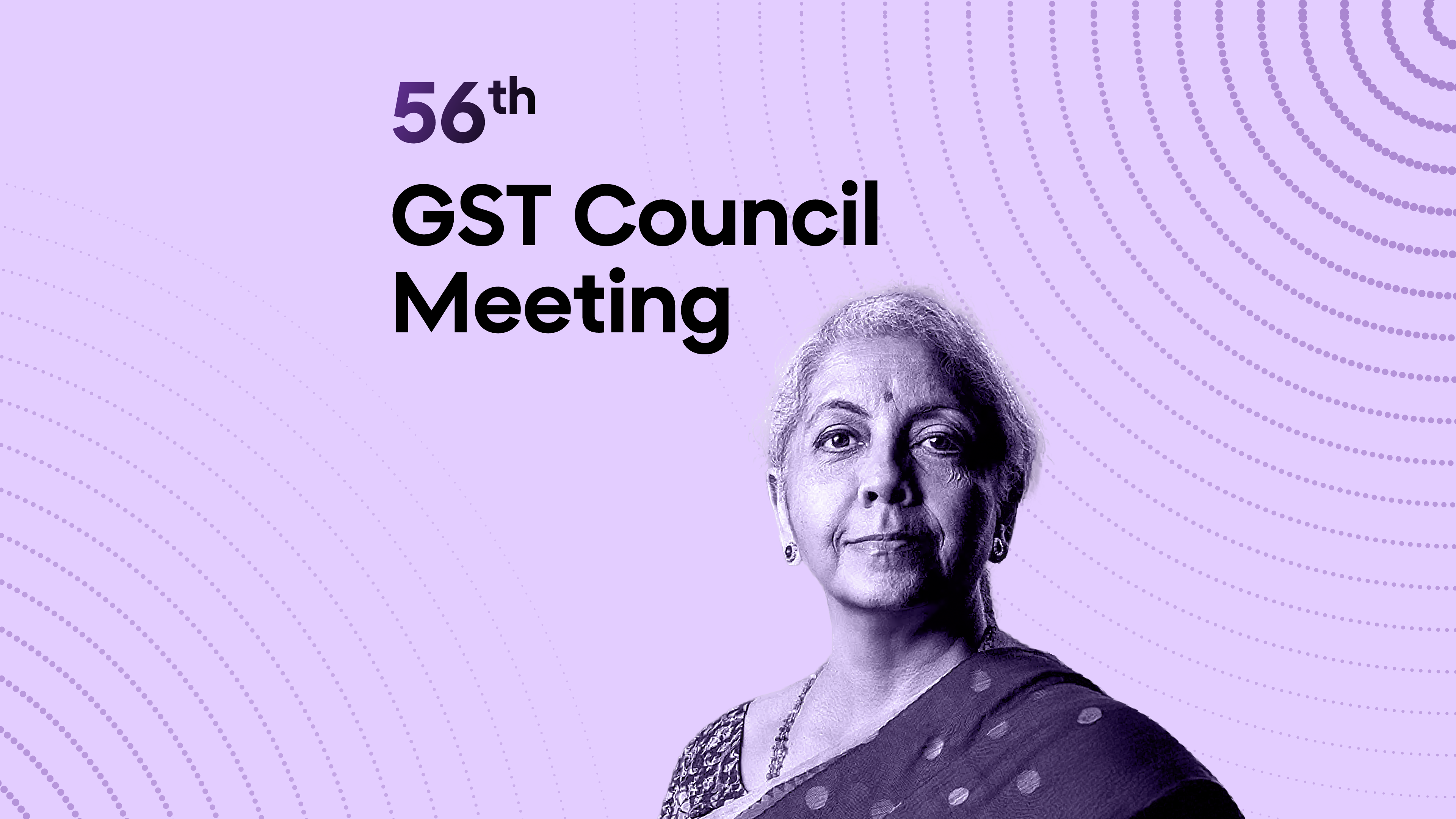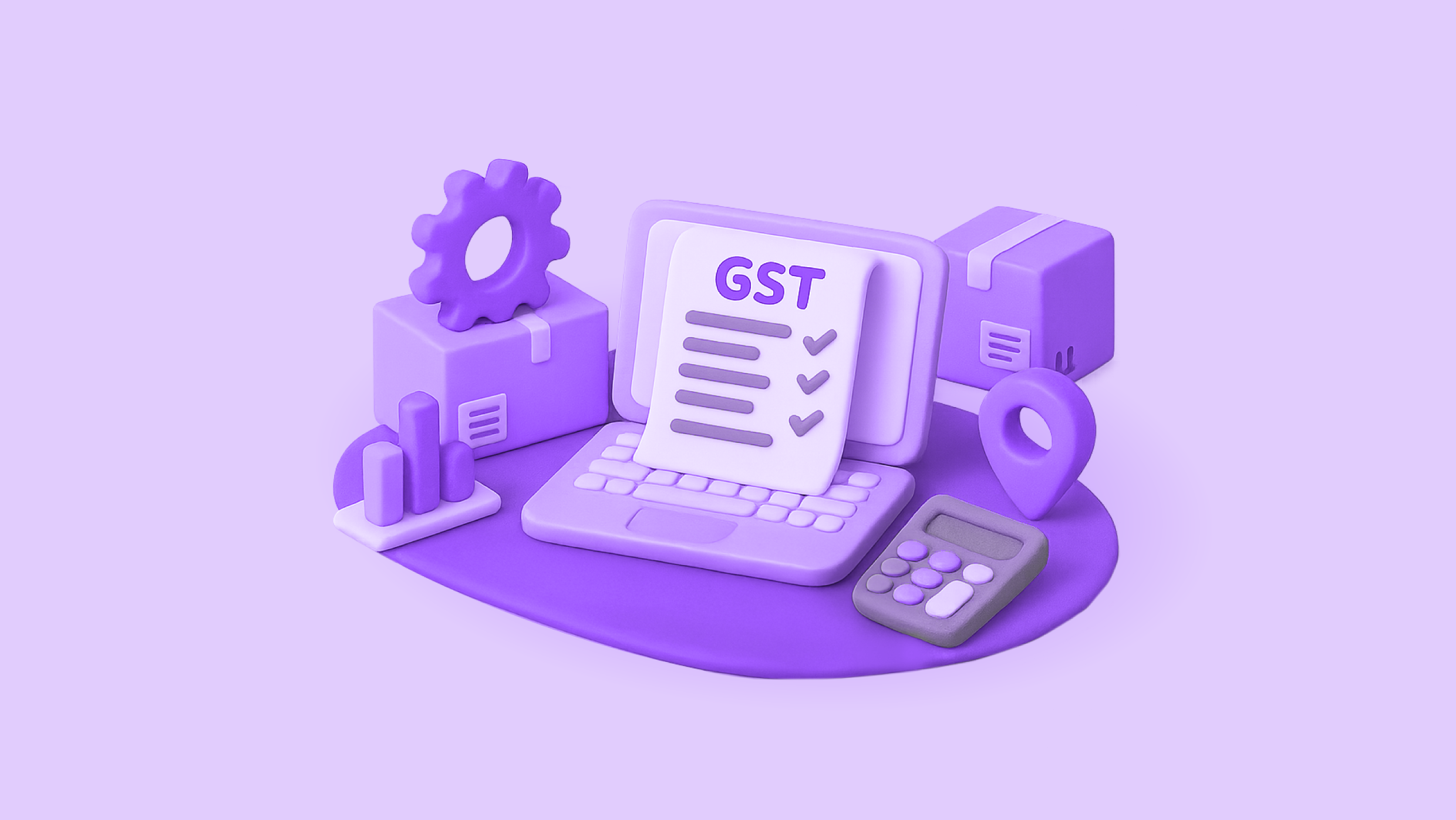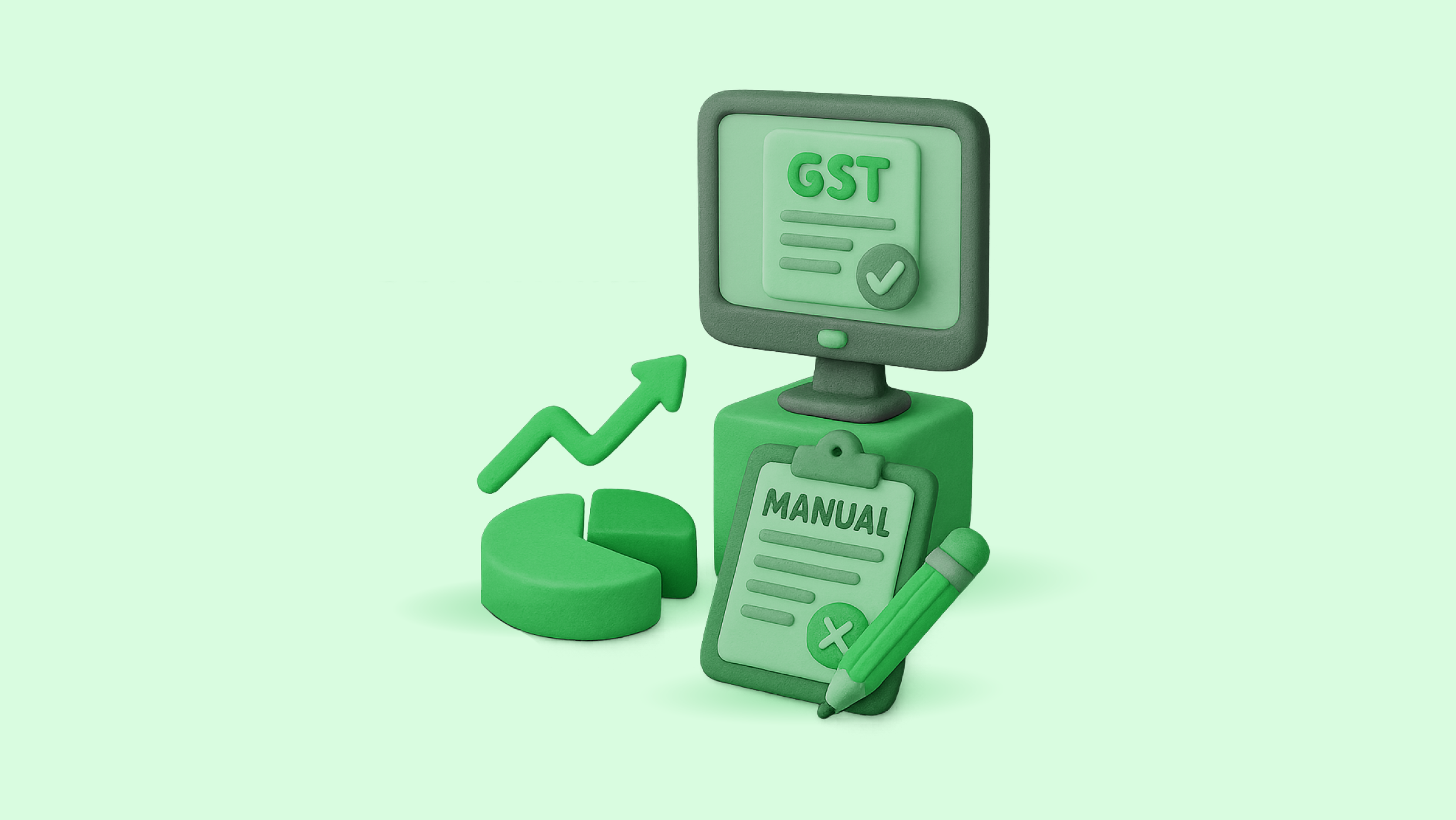The 56th GST Council Meeting, chaired by Finance Minister Nirmala Sitharaman on September 3–4, 2025, in New Delhi, has delivered historic GST reforms. Announced earlier as part of the Prime Minister’s Next-Generation GST roadmap (15th August 2025), these changes mark the most sweeping overhaul of India’s indirect tax system since GST’s launch in 2017.
The new rates will take effect from September 22, 2025.
(except for tobacco and pan masala products)
Highlights of the 56th GST Council Meeting
At the core of the reforms is a simplified GST structure:
- The 12% and 28% slabs have been removed, with items moved into the 5% merit rate or the 18% standard rate.
- A special 40% de-merit rate has been introduced for luxury and sin goods.
- Inverted duty structures in key sectors such as fertilisers and textiles have been corrected.
- Beyond rate changes, the Council has also approved several structural and compliance-related reforms:
- Retail Sale Price (RSP)-based valuation will now apply for pan masala, gutkha, cigarettes, and other tobacco products instead of transaction value.
- Clarifications issued for services – a standalone restaurant cannot classify itself as “specified premises” to charge GST at 18% with ITC.
- Valuation rules for lotteries have been aligned with rate changes.
- Automatic GST registration within three working days for low-risk applicants and those with limited ITC claims (benefiting nearly 96% of new applicants).
- Provisional refunds: 90% refund on claims from inverted duty structure and zero-rated supplies will be granted based on automated, risk-based evaluation from 1st November 2025.
- Refunds on low-value export consignments (via courier and post) will no longer face threshold restrictions.
- Simplified registration for small e-commerce suppliers across states has been approved in principle.
- Place of supply provisions for intermediary services under IGST have been amended to align with international trade norms.
- Post-sale discount rules simplified: discounts must be passed via GST credit notes, with corresponding ITC reversal by recipients where applicable.
- Operationalisation of the GST Appellate Tribunal (GSTAT): Appeals to be accepted before 30th September 2025, hearings to commence before 31st December 2025, with 30th June 2026 set as the deadline for backlog appeals. The Principal Bench will also act as the National Appellate Authority for Advance Ruling.
Most rate changes will apply from 22nd September 2025, while tobacco and pan masala will continue at 28% + cess until all compensation cess liabilities (loans and interest) are cleared.
GST Rate Changes at a Glance
| Category | Items | From (%) | To (%) |
| Daily Essentials | Hair Oil, Shampoo, Toothpaste, Toilet Soap Bar, Tooth Brushes, Shaving Cream | 18 | 5 |
| Butter, Ghee, Cheese & Dairy Spreads | 12 | 5 | |
| Pre-packaged Namkeens, Bhujia & Mixtures | 12 | 5 | |
| Utensils | 12 | 5 | |
| Feeding Bottles, Napkins for Babies & Clinical Diapers | 12 | 5 | |
| Sewing Machines & Parts | 12 | 5 | |
| Farmers & Agriculture | Tractor Tyres & Parts | 18 | 5 |
| Tractors | 12 | 5 | |
| Specified 12 bio-pesticides and micro-nutrients | 12 | 5 | |
| Drip Irrigation System & Sprinklers | 12 | 5 | |
| Agricultural, Horticultural, or Forestry Machines (Soil Preparation, Cultivation, etc.) | 12 | 5 | |
| Healthcare | Individual Health & Life Insurance | 18 | Nil |
| Thermometer | 18 | 5 | |
| Medical Grade Oxygen | 12 | 5 | |
| All Diagnostic Kits & Reagents | 12 | 5 | |
| Glucometer & Test Strips | 12 | 5 | |
| Corrective Spectacles | 12 | 5 | |
| 33 drugs and medicines (as per press release) | 12 | Nil | |
| Agalsidase Beta, Imiglucerase, and Eptacog alfa activated recombinant coagulation factor VIIa drugs | 5 | Nil | |
| Drugs and medicines such as Faricimab, Pertuzumab, Fluticasone Furoate + Umeclidinium + Vilanterol FF/UMEC/VI, Ocrelizumab, and Brentuximab Vedotin | 12 | 5 | |
| Automobiles | Petrol & Petrol Hybrid, LPG, CNG Cars (≤1200cc & ≤4000mm) | 28 | 18 |
| Diesel & Diesel Hybrid Cars (≤1500cc & ≤4000mm) | 28 | 18 | |
| 3 wheelers | 28 | 18 | |
| Motorcycles (≤350cc & below) | 28 | 18 | |
| Motor Vehicles for the transport of goods | 28 | 18 | |
| Education | Maps, Charts & Globes | 12 | Nil |
| Pencils, Sharpeners, Crayons & Pastels | 12 | Nil | |
| Exercise Books & Notebooks | 12 | Nil | |
| Eraser | 5 | Nil | |
| Electronic Appliances | Air Conditioners | 28 | 18 |
| Television (above 32″) (including LED & LCD TVs) | 28 | 18 | |
| Monitors & Projectors | 28 | 18 | |
| Dish Washing Machines | 28 | 18 | |
| Services | Hotel stays ≤ ₹7,500 | 12 | 5 |
| Gyms, salons, yoga centres, wellness services | 18 | 5 | |
| Mining | Coal, lignite, peat | 5 | 18 |
| Sin and Luxury Goods | Pan masala | 28 | 40 |
| Aerated waters | 28 | 40 | |
| Caffeinated beverages | 28 | 40 | |
| Carbonated beverages of fruit drinks / with fruit juice | 28 | 40 | |
| Other non‑alcoholic beverages | 18 | 40 | |
| Motor cars and larger hybrids (beyond small‑car thresholds) | 28 | 40 | |
| Motorcycles exceeding 350cc | 28 | 40 | |
| Aircraft for personal use | 28 | 40 | |
| Yachts and vessels for pleasure/sports | 28 | 40 | |
| Smoking pipes and cigarette/cigar holders | 28 | 40 | |
| Revolvers & pistols | 28 | 40 | |
| Admission to casinos, race clubs, and sporting events like IPL | 28 with ITC | 40 with ITC | |
| Licensing of bookmakers by race clubs | 28 with ITC | 40 with ITC | |
| Specified actionable claims (betting, casinos, gambling, horse racing, lottery, online money gaming) | 28 with ITC | 40 with ITC | |
| Leasing/rental without operator of goods attracting 40% GST | 28 with ITC | 40 with ITC | |
| Paper Industry | Dissolving‑grade chemical wood pulp | 12 | 18 |
| Various papers/paperboards, other than exercise‑book paper | 12 | 18 | |
| Textiles | Apparel/Made‑ups > Rs 2,500 per piece | 12 | 18 |
| Quilted/cotton quilts and quilted products more than Rs.2,500 per piece | 12 | 18 |
Bottomline: The 56th GST Council Meeting has officially rolled out GST 2.0 – a simpler 2-slab system, lower rates on essentials, exemptions for healthcare & education, relief for farmers and MSMEs, and stronger compliance processes. This reform is expected to boost consumption, ease compliance, and make GST more citizen-centric.
The 56th GST Council Meeting, scheduled for 3rd and 4th September 2025 in New Delhi, is set to be one of the most crucial sessions since the implementation of GST in 2017. With Prime Minister Narendra Modi announcing “Next-Generation GST Reforms” on the 79th Independence Day (15th August 2025), all eyes are now on the Council to roll out a more simplified and growth-oriented GST framework.
Expectations from the 56th GST Council Meeting: GST 2.0 on the Horizon?
1. GST Rate Rationalisation – Towards a 2-Slab System
One of the biggest reforms under discussion is the restructuring of GST rate slabs. Currently, GST operates under a four-tier system (5%, 12%, 18%, 28%), along with a special 40% rate for sin goods.
The proposal under review:
- Merging slabs into two primary rates: 5% & 18%
- 40% rate to remain for sin goods & ultra-luxury items
Likely changes in this rationalisation:
- Goods currently taxed at 12% may be reduced to 5%, covering essentials such as toothpaste, butter, cheese, namkeen, personal care items, and textiles.
- Items under the 28% slab may reduce to 18% – including electronics, appliances, and small cars.
- Insurance premiums (currently at 18%) may drop to 5% or even become exempt.
This rationalisation could ease inflationary pressure, boost consumer demand, and spur economic growth, while simplifying compliance for businesses.
2. Addressing Inverted Duty Structures
Several industries, including textiles, footwear, fertilisers, paper, and packaging, continue to face an inverted duty structure – where input taxes are higher than output taxes, leading to blocked Input Tax Credit (ITC) and working capital crunches.
The GST Council is expected to:
- Propose a phased correction of these anomalies.
- Provide industries adequate time to adjust to new rates.
- Ensure measures to prevent anti-profiteering disputes during implementation.
3. Review of Compensation Cess
The GST compensation cess – a key revenue-sharing mechanism for states – was extended until 31st March 2026. At this meeting, discussions are likely to revolve around:
- Whether to replace it with a new levy, such as a Health and Clean Energy Cess post-2026.
- How to balance state revenues once cess collections phase out.
4. GST on Insurance, Drones & Emerging Sectors
Several sector-specific GST issues may see clarity:
- Insurance: The Council is expected to deliberate on reducing or exempting GST on health and life insurance premiums (currently taxed at 18%), a move that could significantly benefit households.
- Drones: A uniform 5% GST rate for commercial drones is being considered, replacing the fragmented tax structure (5% for business drones, 18% for camera drones, 28% for personal-use drones). This could accelerate drone adoption across agriculture, logistics, and infrastructure sectors.
- Virtual Digital Assets & E-commerce: Clarifications may be issued on taxation of digital assets, real estate, and gaming.
5. Pre-Filled Returns & Automated Refunds
The Council may also deliberate on pre-filled GST returns and automated refund processes as part of GST 2.0 reforms. These measures aim to:
- Reduce manual errors in return filing.
- Ensure faster credit of refunds to taxpayers.
- Strengthen compliance with minimal intervention.
Why the 56th GST Council Meeting Matters
This meeting isn’t just another policy review. It is expected to be the launchpad for GST 2.0. The expected outcomes could:
- Simplify India’s GST regime by reducing slabs.
- Encourage consumption by lowering taxes on essentials and consumer goods.
- Support businesses through the rationalisation of inverted duty structures.
- Balance state and Centre revenues with a cess roadmap.
- Lay the foundation for a more automated, transparent GST compliance ecosystem.
With inflation control, consumer relief, and ease of doing business at stake, the Council’s decisions will directly impact households, industries, and state finances alike.





